CHAPTER 3 - ARTIFICIAL GRAVITY
The centrifugal system
Customizable ships
Mass balance
Gravity on the planets
Magnetic gravity
Space cities
Black Holes
CHAPTER 4 - THE POTENTIAL OF THE UNIVERSE
The evolution of potential
Happiness and wealth
The rule and the exception
Good and evil
The origin of evil
The mind of a tyrant
The connection of matter
FOREWORD
With this book I intend to resolve the doubts of those readers who after reading my previous books have been left without a clear idea about the exact way I raise my graphics. These books are complex enough to be suitable for further clarification. I also take this occasion to bring any new ideas that could be useful to better promote their understanding. To make these graphics I used a fairly simple program, so that the result does not have great accuracy, but I think the most important thing is not the accuracy of the design but the reader to understand its meaning easily.
Some of the schemes of this book rather than classified as philosophical, it would be more correct to define them as metaphysicians therefore may be difficult to understand. I think people spend very little time to reflect on the world around us, because they understand that meditation can help us better understand the universe, and from there engage ourselves in their construction. Modern man has a high level of technological development, but in my opinion the moral level is not higher than the cavemen. Unfortunately too easily carried away by those trying to manipulate him, this will serve as alleged reasons or evidence, but what people do not understand is that you can find arguments to defend almost anything, no matter how absurd it is.
The key internal development is to not get carried away by precipitation, as they want fraudsters. Therefore, we must analyze things calmly and always seeking the truth. Perhaps the greatest contribution of this book is to try to give a scientific explanation of what normally only usually analyzed from the philosophical point of view.
This book has been translated from the original Spanish version.
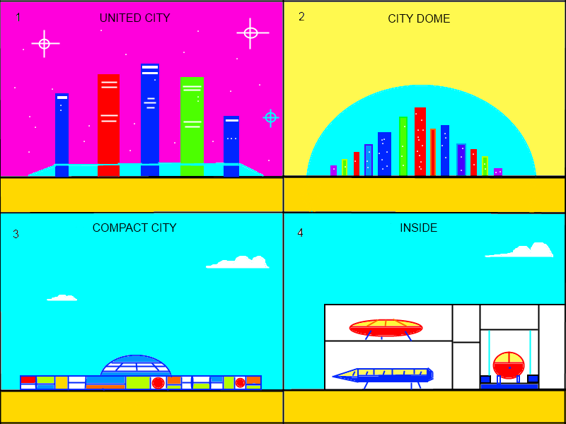
CHAPTER 1 - THE PROGRESS OF CITIES
From the beginning of time man has always tried to find the most appropriate way to feel protected and as far as possible with all their needs met in this way it is how came the first villages, which then end up becoming cities. In this chapter I will try to explain how they could be future cities.
THE UNITED CITY
Currently, cities have evolved to be a sum of large buildings.
These buildings have air conditioning systems inside that protect their tenants fairly adequate. However, the problem occurs when you go outside because the building climate protection is lost by being the population exposed to a climate that is often much hotter or much colder than adequate.
A solution to avoid these problems, could be the image displayed on the first scheme, consist of a glass cover that would unite all city buildings by preventing the entry of outside weather. With this simple system, air conditioning present within the buildings would also remain abroad, with economic savings that would also benefit for people, because they could end forever with the annoying weather whims.
THE CITY DOMED
Another possible solution is what we see in the second scheme.
By using materials resistant domes not only the protection of citizens against adverse climates is achieved, but also of the buildings at the risk of falling aircraft or meteors. Furthermore, this method would also be useful to create an ideal microclimate on any planet or moon that humanity would go live.
THE COMPACT CITY
In the third scheme we see this concept of integrated city in a more advanced way, it is what might be called the compact city.
This kind of city is the result of eliminating unnecessary separation between buildings, to create a kind of ship city. This system can take advantage of all the spaces and also greater protection for its inhabitants is achieved because the dome cities there is always the risk that it could break the dome, causing the entry of toxic gases or air loss inside those worlds lacking atmosphere. The model seems more suitable is shown in the image. It consists of a circle of five to ten kilometers and one hundred to two hundred meters high, except in its central dome which would be much higher.
In the fourth picture we see inside the hangars for the ships vertical takeoff that surround its entire periphery. Joining them means like trains transport would be found, but unlike today a transparent wall would separate the pedestrian area of the train to avoid the risk of falling onto the tracks, trains would be synchronized so that when you reach stations would stop just at the point where the doors for the entry of travelers find. This
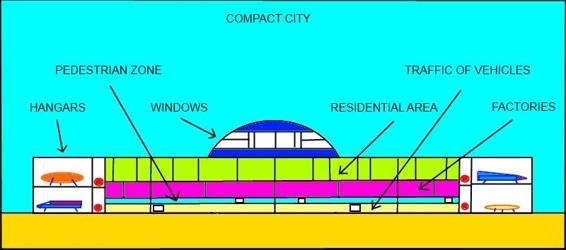
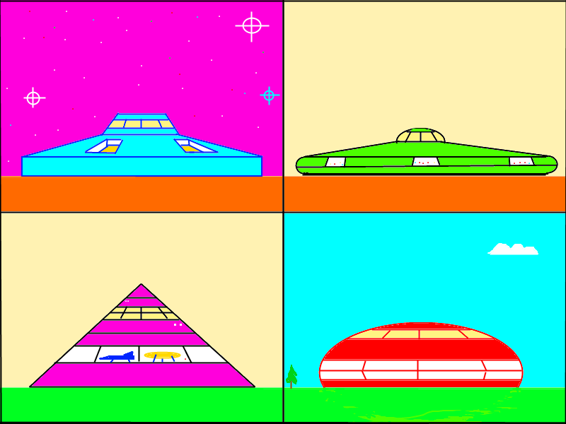
system would work like double-door elevators, in order to prevent passengers can be in direct contact with the train.
In this type of city transport vehicles would use the lower section.
Located above section would be used for pedestrian traffic, to avoid the risk of abuse. On top of this section would be the area of factory and office work. Finally above all would be located residential areas where housing would be found.
In these designs other possible types of compact cities are shown, as you can see there are many models that can be used, but in all cases share the characteristic of being a safe and appropriate structure to live in any climate. In these cities the indoor air would be recycled forever keep the amount of oxygen needed.
CHAPTER 2 - CRAFT OF THE FUTURE
VERTICAL TAKEOFF CRAFT
It is surprising that at present do not yet exist widely vertical takeoff vehicles for passenger transport. These vehicles are much safer than typical aircraft because the aircraft are very vulnerable at times of takeoff and landing due to the effect of wind gusts have on the wings. The best vehicle for passenger transport is undoubtedly the vertical takeoff, but I do not mean the classic helicopter, since this device is nothing more than an airplane but with the rotary wing, I mean a device that takes its engines fully integrated in the fuselage. Helicopters are worse means of transport that the model proposed here, because although they can take off from anywhere, however, can be affected by wind gusts as aircraft and also the risk that their rotating blades collide with other elements run of the outside. Vertical takeoff vehicles could also be fitted with a safety system consisting of an integrated fuselage to minimize the risk of damage to the engines parachute.
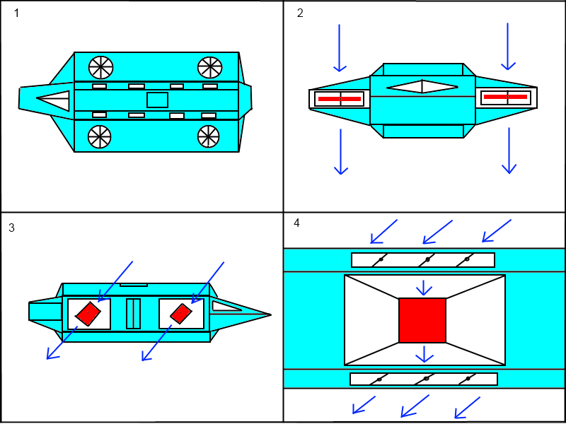
In these schemes we can see how these ships could be vertical takeoff. As shown in the first drawing engines they are perfectly integrated into the fuselage of the device, which reduces the risk of collision of the blades with external objects. In the second scheme inner helices can function without any problems sucking air from above and blowing it down. In the third scheme we can see how the shift would be carried forward, it is sufficient to tilt motors for the displacement of the aircraft occurs. In the fourth drawing one can see a different type of engine, in this case could be a fixed reaction engine. Above and below the engine a rotating horizontal grids remain in landing position would find themselves situated. At the time of takeoff would upright for outside air to pass without difficulty down. For the forward movement would be sufficient that the grids to bow down and then the vehicle start to move horizontally. Compartment above the fuselage for emergency parachutes that would give this vehicle a level much higher than today's airplanes would find safety.
SPACE LUNCH
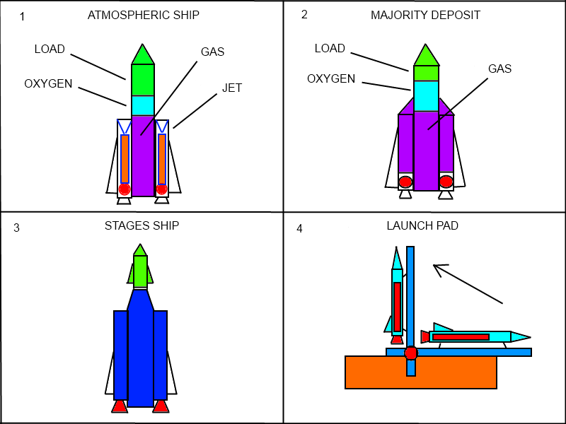
Since the beginning of the space race have created many types of ships to send payloads into space, but the most common is that consisting of several steps are eliminated as the fuel is over. In my opinion, it would be better to create a prototype that was fully reusable spacecraft to minimize launch costs. In the diagram below shows several possible models.
In the example number one atmospheric model ship is shown, this type of ship is single stage and has the advantage of carrying two turbojet engines that use atmospheric oxygen to accomplish the mission. This allows great fuel savings by not having to transport most of the oxygen.
In the second example see the ship model majority tank, these ships are characterized by most of its fuselage occupied by fuel and only the front part contains the payload, this type of craft is single stage but it lacks engines aspiring atmospheric oxygen, so they are only useful on those planets that do not have it. It could also be that the characteristic pattern of interstellar craft, in this
case could be used as a source of nuclear energy and the reaction mass would be obtained from the gases contained in comets or meteorites. Another acceptable option would be to use the gas giant planets like reaction mass, taking into account the large amount of gas that these ships may need. Thus these planets act as space stations.
The third model ship is the space shuttle type (Space Suttle), but unlike her all parts are reusable. Actually it consists of two connected vessels, the first serves to lift loading and transport of fuel and the second carries the payload. In this type of ships it is the best that the cargo ship is placed above the ship fuel, because that in case of explosion or failure of the main engines have the opportunity to secede from the stage shuttlecraft time to escape.
Once the two phases are separated, each will return to the base on their own. Another measure of adequate security, manned spacecraft would be used only in the case of passenger transport, because it is absurd to risk the lives of crew for shipment of goods where there are already adequate to do this automatically technical means.
In the fourth scheme we could as be the launch pads to be more efficient, in the example can be seen as the ship is first placed on the platform as you would any apparatus conventional vertical takeoff, once the ship was fixed at its anchors the platform is inclined to stand upright, then begin the process of filling fuel, thus being overweight posed fuel for landing or wings if they were to do this in a horizontal position would be avoided. In addition, this system only the rear motors are required to perform their task, however few simple motors located under the fuselage to allow the ship to land conventionally, once it was freed from the load and fuel.
Another system that will surely have a great success in the future for sending payloads into space, are electromagnetic catapults, these objects would consist of a long tube to the spacecraft launch would be introduced, then a strong magnetic accelerator would print on ship fast enough to counter planetary gravity. Having achieved this, the ship would use its own engines to continue the journey. The great advantage of this system is that it would be necessary to transport heavy fuel it takes to reach orbit, but its
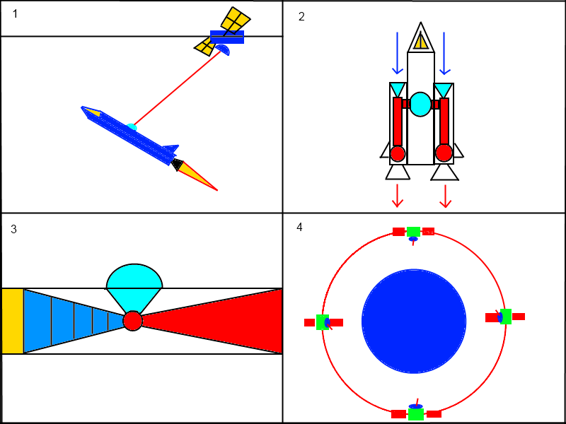
drawback is that it is only useful in the worlds no atmosphere like the moon, this is because the atmosphere creates friction which greatly hinder the process.
LASER CRAFT
Other ships could be laser ships, i.e. ships that would transport the fuel of the first stage, but a satellite in orbit would provide the necessary energy. Such vessels would only use the conventional way fuel when starting off or when they met near the space, to be impossible in this case the use of the global atmosphere. The approach would be a satellite in low orbit, it emits a laser beam of high-energy long enough for a spacecraft achieved orbit placed near, time that would use its own engines. This process lasted about fifteen minutes, during which the satellite would follow the same path as the space ship.
In the first scheme we can see the satellite image accompanying the ship in the process of lifting into space, period during which
the laser beam act as a power supply. In the second scheme we can see the design of the ship provided engines and lens responsible for collecting energy. In the third scheme we see a simple reactor design, with the combustion chamber and the beam receiving lens. In the fourth scheme we can get an idea of the position of power satellites would use to meet the ships from anywhere on the planet.
Once the ship had reached a height of about ten kilometers the laser beam begin to act and be picked up by the lens above the nave. To avoid the risk of diversion of lightning, the high-energy laser would be preceded by a low-energy mission would establish synchronization between the satellite transmitter and the receiving ship. This would happen automatically by computers. Another security measure would be to use only uninhabited areas, mainly marinas,
for
the
flights.
Once
had
been
established
synchronization, power mirrors send received the combustion chambers on the sides of the ship. Such craft absorb atmospheric air and once were within the combustion chamber and the laser would heat the reaction mass would use as well as would the chemical fuel. As the ship was approaching the space would be easier to aim the beam, being less than the distance between the transmitter and receiver. In addition, the air would become increasingly scarce, so the beam could pass more easily through it. When approaching the ship into outer space, conventional propulsion engines would be activated for a few minutes so the ship would reach a stable orbit. For this to be an effective system for lifting loads into space, it would be necessary to maintain a sufficient number of power satellites. The great advantage of this system is to dispense with the heavy weight of the fuel of the first stage, besides getting free energy, because that energy would be achieved in the space directly from the sun.









